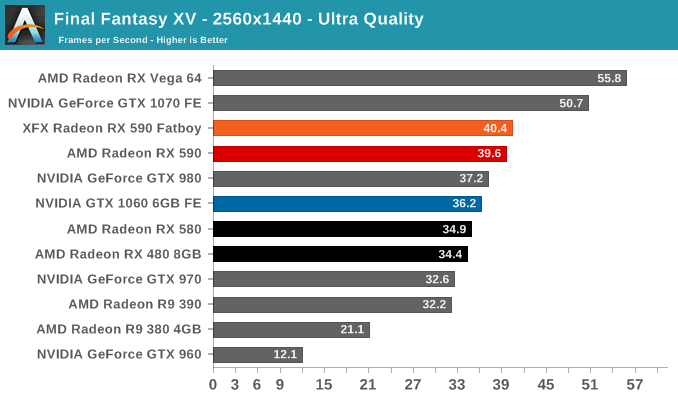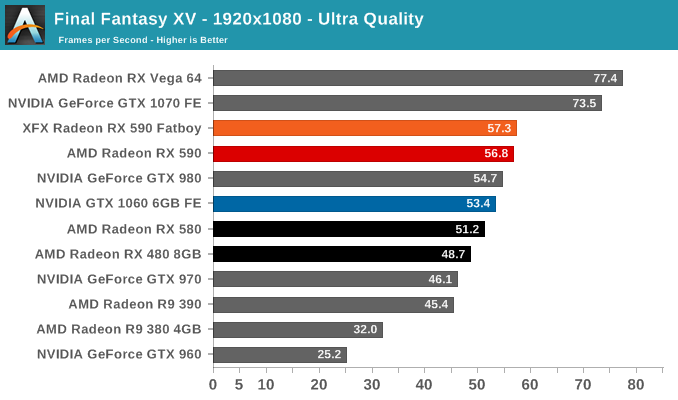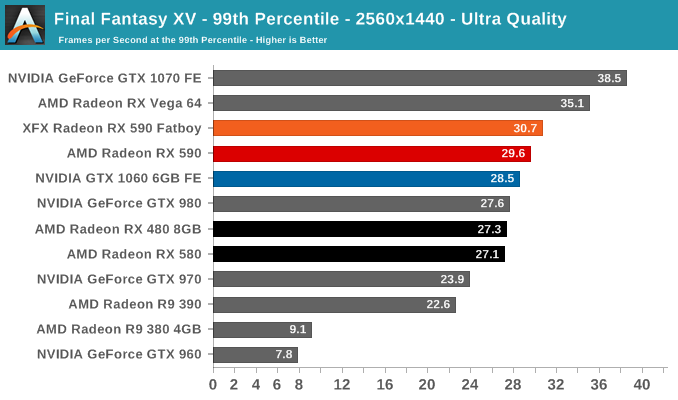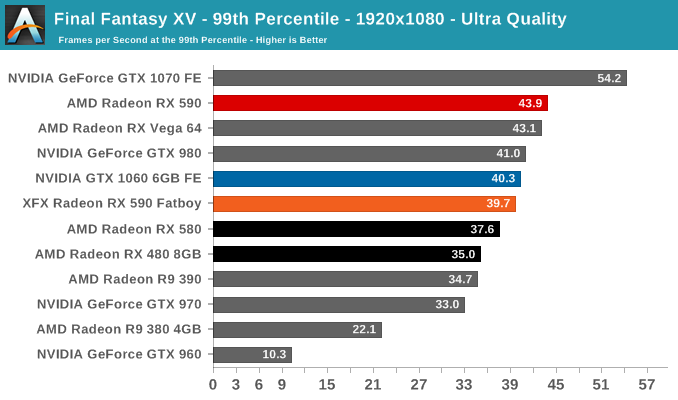The AMD Radeon RX 590 Review, feat. XFX & PowerColor: Polaris Returns (Again)
by Nate Oh on November 15, 2018 9:00 AM ESTFinal Fantasy XV (DX11)
Upon arriving to PC earlier this, Final Fantasy XV: Windows Edition was given a graphical overhaul as it was ported over from console, fruits of their successful partnership with NVIDIA, with hardly any hint of the troubles during Final Fantasy XV's original production and development.
In preparation for the launch, Square Enix opted to release a standalone benchmark that they have since updated. Using the Final Fantasy XV standalone benchmark gives us a lengthy standardized sequence to utilize OCAT. Upon release, the standalone benchmark received criticism for performance issues and general bugginess, as well as confusing graphical presets and performance measurement by 'score'. In its original iteration, the graphical settings could not be adjusted, leaving the user to the presets that were tied to resolution and hidden settings such as GameWorks features.
Since then, Square Enix has patched the benchmark with custom graphics settings and bugfixes to be much more accurate in profiling in-game performance and graphical options, though leaving the 'score' measurement. For our testing, we enable or adjust settings to the highest except for NVIDIA-specific features and 'Model LOD', the latter of which is left at standard. Final Fantasy XV also supports HDR, and it will support DLSS at some later date.


For Final Fantasy XV, the older R9 380 and GTX 960 simply can't keep up with the demands and are essentially unplayable with particularly low 99th percentiles. VRAM wouldn't be the sole issue - though FFXV does use high resolution textures - as the GTX 980 (4GB) performs up to par. NVIDIA hardware tends to perform well on FFXV but as with Ashes: Escalation, the RX 590's extra performance permits it to claim victory, reference-to-reference, which the RX 580 was unable to do here.













136 Comments
View All Comments
neblogai - Thursday, November 15, 2018 - link
For me, and many other people 2080 or 2080Ti might as well not exist. I'd never buy any GPU priced like that. In fact, I'd never even buy a €300+ card. Also- power use is not an issue- at 200W+, it is easy to cool, not noisy, and savings in electricity cost from having a GTX1060 would be only €5-10 per year (at 20 hour gaming per week, which I do not achieve). And in a sub-€300 market- nVidia has not offered anything for 2.5 years. So it is certainly better deal to buy a faster RX590 and get a €180 AAA game bundle for free, compared to similarly priced, slower GTX1060. There are other reasons as well, like Freesync, and futureproofing like 8GB of VRAM and better driver support (because nVidia will be moving toward doing optimizations for 20xx series).eva02langley - Thursday, November 15, 2018 - link
It is a polaris card. Everybody knew what to expect. I am not sure what you are talking about.Navi is due next year and the contender will be the 2070 RTX. I am going to speculate a tag price of 300$ which is a whole 200-300$ less than a RTX.
mapesdhs - Thursday, November 15, 2018 - link
Xex360, AMD is not trying to compete because just don't buy them, so what's the point? There market and brand awareness simply isn't there to support a high end product stack atm, not until gamers stop being so irrational and actually buy AMD when they are objectively the more sensible option, whether based on price, performance or some combination of metrics.Cooe - Thursday, November 15, 2018 - link
"but now built on GlobalFoundries' 12nm process"Sorry, Nate, but ya got that one wrong. Polaris 30 is being fabbed at TSMC, just like the rest of AMD's GPUs.
eva02langley - Thursday, November 15, 2018 - link
... sure....porcupineLTD - Thursday, November 15, 2018 - link
Where are people getting this from?Ryan Smith - Thursday, November 15, 2018 - link
Note that we currently have no information cooroborating the use of TSMC. And indeed it seems incredibly unlikely given AMD's WSA, and the fact that Polaris 30 has the exact same die size as Polaris 10. TSMC and GF's 12nm processes are not identical, porting a chip to TSMC would given you different geometry dimensions.lmcd - Friday, November 16, 2018 - link
Just like the rest of AMD's...https://www.anandtech.com/show/10446/the-amd-radeo...
GPUs. Right.
maroon1 - Thursday, November 15, 2018 - link
What a jokeOnly 12% faster but also cost and consume more power than RX580 (and 108watt more than GTX 1060 at load)
It adds noting new. It just fills the big gap between RX580 and vega56
dr.denton - Saturday, November 17, 2018 - link
"It adds noting new. It just fills the big gap between RX580 and vega56"Literally all it was ever intended to do. Polaris is a 2 year old mid range GPU design, how do you expect anything revolutionary from that?